Travel Days
India February and March 2014, with Tropical Ice

 Bookmark this on Delicious
Bookmark this on Delicious
 Recommend to StumbleUpon
Recommend to StumbleUpon

This page has gaps and rough edges.. but I hope you will feel that there's enough Good Stuff by now that it was okay for me to publish it? Turning to our trip....
You want it all? You had better be up for for What It Takes!
Tropical Ice has a global reputation. In our group, there were people from the US, the UK, Canada. What do you notice? Yes! They are all a long way from India! Sadly, wonderfully, India has lots of Good Stuff. Compared to, say, New York/ Delhi, the Good Stuff included in the Tropical Ice Passage to India program is all quite "close"... but just because they are closer than New York and Delhi doesn't mean that you can get from one bit of Good Stuff to another in 45 minutes. You also need to factor in the fact that getting from "A" to "B" in India isn't quite as simple as getting from New York to Boston. BUT IT IS WORTH IT!!! If you've come all the way from New York, don't you want to sample more than one of the great things India has to offer?
And my last word on the subject, before we get to some details and photos? The journeys themselves... if long... were fascinating. I never really grasped how big India is, nor quite what was meant by the "rural" areas.
Of course, the areas of teeming millions are part of India's story. We've all seen the photos of life in the densely populated parts of India....
.. but have a look at this map of population density....
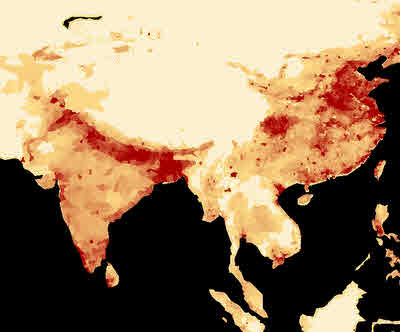
What image comes to mind, when you think "India"? Teeming masses? Look at the map. Yes, there ARE places with teeming masses, but that's not the whole story. Did you realize that is how the people are distributed? They are concentrated in the watershed of the sacred Ganges. In most of the country, it is a different story. A story you will become more familiar with, if you take the Tropical Ice trip.
(Map from an interested discussion on link between heavy rains and high death tolls (globally), said to be from NASA, but the link given (http://veimages.gsfc.nasa.gov//116/pop_density.jpg) is out of date.)
We flew from Delhi to Bhopal in the late afternoon of the 24th, going to a hotel in town after landing in Bhopal. (Yes... that Bhopal, where the terrible tragedy (-WP-) took place in 1984.)
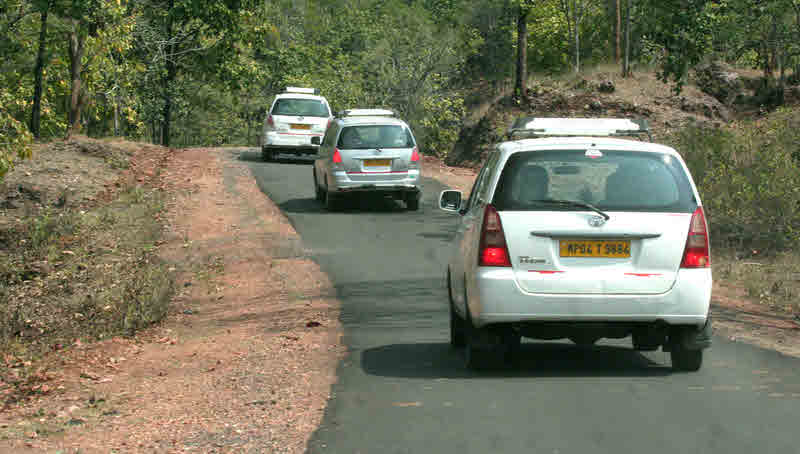
Then, the next morning, the 25th, we had our first journey in one of the "convoys" which would become familiar... but not too familiar. (Vegetation: the picture comes from the end of the 25th, as we got close to the Satpura National Park.)
The vans were comfortable, and, as was so often the case in matters where "mere" human labor is the only necessary ingredient, spotless, inside and out.
The drivers were excellent. We had some long journeys, in challenging traffic (I'll say more about that along the way), among other things always striving to catch opportunities to overtake slower vehicles. They maintained concentration admirably. On one occasion, after about three hours of driving, one of our drivers swerved instantly, and saved... by inches... the life of a man who tried to dart across the road behind a bus coming the other way. It would have been no fault of our driver if he had hit the pedestrian... but he didn't. Again, as always, the drivers were extremely courteous. They did need a break once in a while for tea... twice we stopped for about 15 minutes. To break six hours of driving into two three hour segments.
As we were going to some "off the beaten track" places, our vehicles had to be appropriate to the roads in parts of the journey, so they weren't large... three of us rode in each, with the back given over to luggage in most cases, or, sometimes, a slightly smaller seat for one or two of the local people looking after us. The surfaces were always good. But sometimes the width of the road and the amount of traffic on it were not well matched.
"The surface was always good..." That is an example of one of the things that fascinated me about India. Even in very remote areas, there were signs of money coming out from Delhi. At least some tax money does seem to get spent on improving people's lives even in areas where you wouldn't imagine there were many votes to "buy".
Our journey on the 25th, from Bhopal to Denwa was broken by a stop at the Bhimbetka Rock Shelters (-WP-) (which I have covered more fully in the "Culture" page). Fascinating for the paintings, of course, but also our first taste of "wild" India.
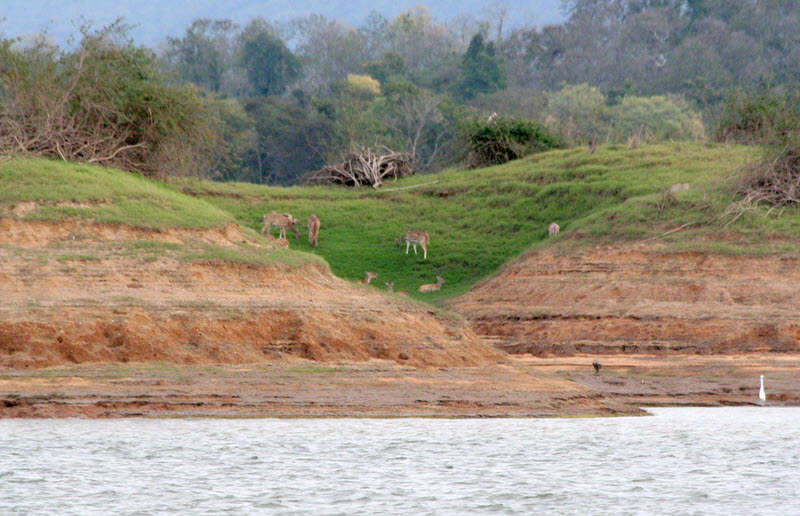
Eventually, we reached the dam creating the reservoir fed by the Denwa and other rivers, and transferred to a fast open boat, in the late afternoon, for a splendid journey up the Denwa arm of the reservoir to the Denwa Backwater Escape... deep in the park. Saw a nice croc on a sandbank, and the chital (spotted deer) (-WP-) captured in the photo on the left, our first large mammal, and an appropriate one. They are a major element of the local food chains, being just the right size. (Male chital averages about 90 cm (35 in) tall at the shoulder.)
So! A fairly gentle introduction to what travel days would mean.
This day's travel was very straightforward. Get in vehicles. Drive. And drive. And drive some more. (Not forgetting the drivers' tea break about halfway through the day.) Mostly flat, open country, with farmland. Quite verdant... trees along road, etc. The occasional small market town. These would have been disastrous, had I been driving myself, because I would have kept stopping, sampling their charms... and arrived at Kanha about 2am.
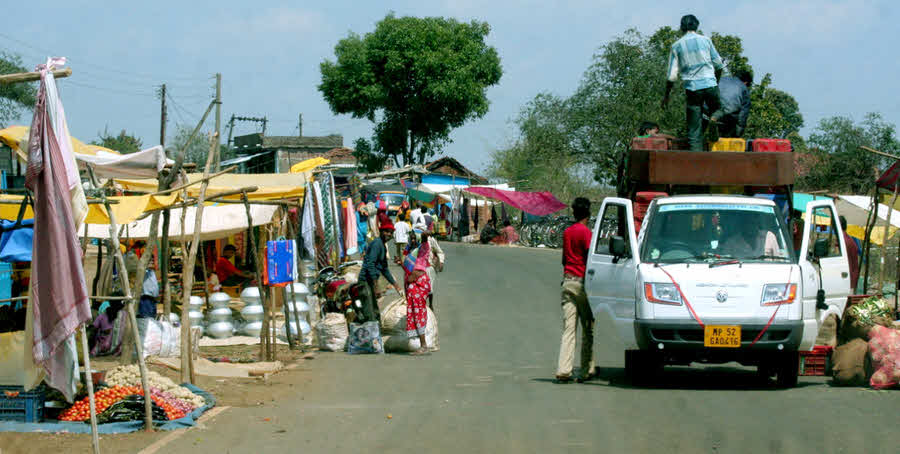
Note the substantial stock of cooking pots... the "silver" things under the awning on the left. They show that this market crossroads is in a more prosperous region than some we encountered. The local merchants have enough capital to have some stock, and there are potential customers. In some places, all you saw in the market was food harvested today, to be exchanged for someone else's slight excess in some other commodity.
Going back to "capital for stock". A different economic model must apply in India. Time and again, you will encounter shops enormously over=stocked. And, in a big city, you will find four or five shops side by side, all bursting with mechandise of the same category. Lots of choice for the consumer. I don't know how the shopkeepers finance keeping so much choice available.
Sometimes I wondered if every person for 50 miles around bought, say, a cooking pot, whether the shop's stock could be exhausted. And cooking pots make a good example. Shops bursting with, say, spices, may have good stock turnover... but how often does anyone need to buy a new cooking pot, or similar durible good? And yet even for such things, the consumer's options... outside of the very poor regions... was excellent.
---
It was during this drive that two of us spotted one of the mysteries of the trip. In the "middle of nowhere", huge warehouses. No identifying logos. No signs proclaiming their ownership or function. I would guess that those who needed to know what they were already did, and not that many "outsiders" passed, to be informed, anyway. Many looked recently build. In the end, we decided that they were grain storage warehouses, the grain being held in large bags. Either for holding local crops, on a "coop" basis, or for taxpayer funded welfare distribution in hard times.
Part of the mystery: The were well equipped with loading dock type doors... but there was little evidence of heavy vehicle coming and going to, from, the doors. (I'll try to find a photo for you.)
Even after a game drive, we were always met by hot towels, a refreshing drink, as we arrived at any lodge, and the welcome when we first arrived was always particularly warm.
This drive had a "feature" to enliven it. We set out from Kanha in an ecosystem of one type, suitable to its elevation. Part way to Bandhavgarh, we spent quite a long time working our way to a higher elevation, but, at the top, instead of then starting down the other side of a range of hills, we found ourselves on a high plateau, with, of course, a different ecosystem, which persisted (with minor shifting) to our destination, Bandhavgarh. (I'll try to find and add suitable photos for you.)
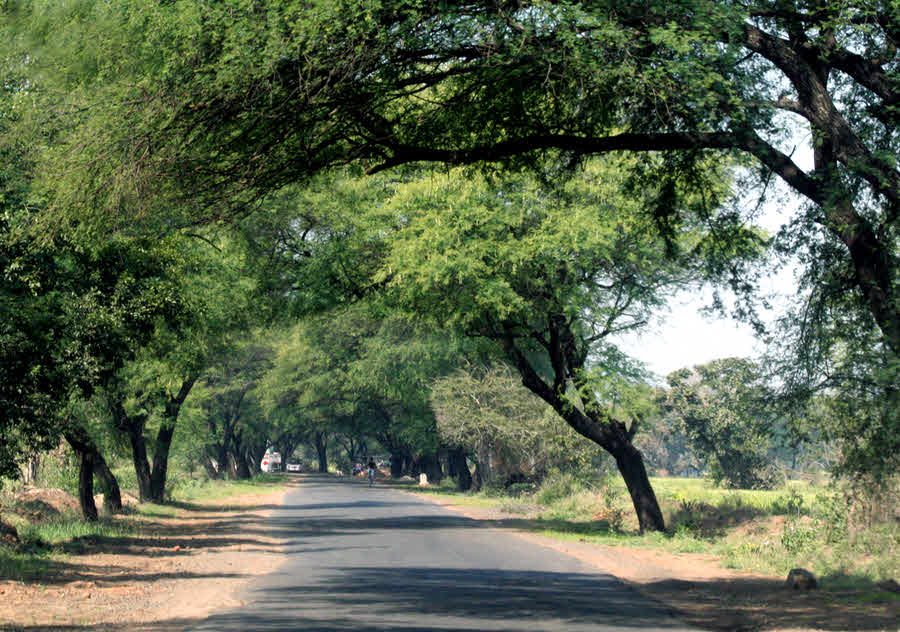
The magnificent on the right was, I'm pretty sure, late in our journey, as we neared Bandhavgarh. Such avenues were rare, but sometimes surviving the need for firewood, etc.
Another "mystery of the land": We would be driving along a long, empty, road. "Nothing" to left or to right. For miles. And then we would pass two schoolchildren, trudging along. Or a man and an ox. Or a woman and child. And then drive more miles thought "nothing". So- Where were they coming from? Where were they going? Why? (They rarely had anything in their hands. The women might have a few things on their heads, but nothing sufficient to justify a three mile walk in the sun.
At 11:25.. having set out a few minutes after 9, we had the driver's tea stop for the day. The only stop. Never re-fueled, no "pit stops". Ten minutes, by my watch.
My beloved Holuxes... two of them... did not cover themselves with glory on this trip. (Although a modern Sony digital camera was also having trouble getting a fix when it shouldn't have had trouble.) But I think the tea stop was at the place shown below, thank you Google Maps...
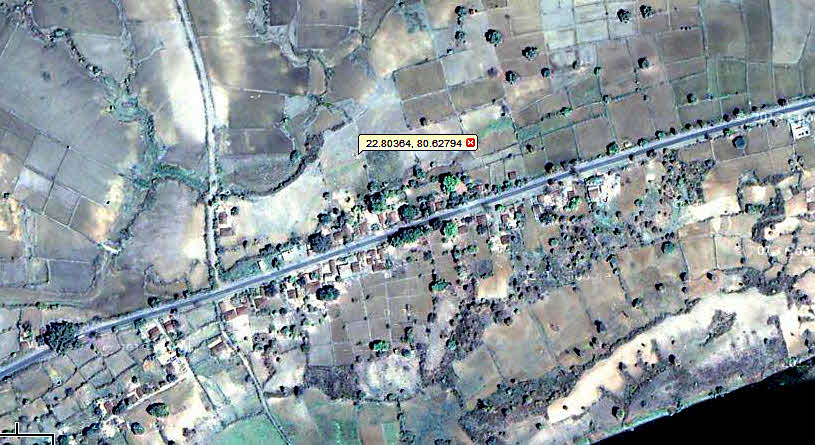
.. if it wasn't, then it was a similar community, not far away. Just a frail cluster of small buildings and sheds, catering to passing traffic, and a focal point for the people of the district. The black "thing" at lower right is the river the road follows, (More on this anon.)
It was also on this journey that we passed by Cement City... a concentrated area blighted by industry, with enough huge cement factories, it would seem, to supply all of India!
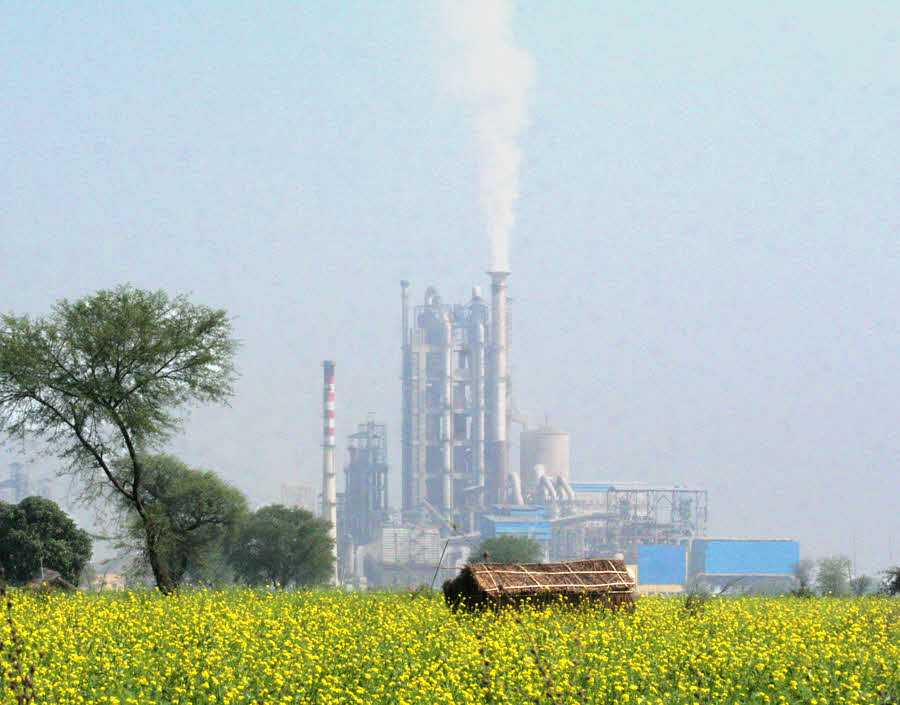
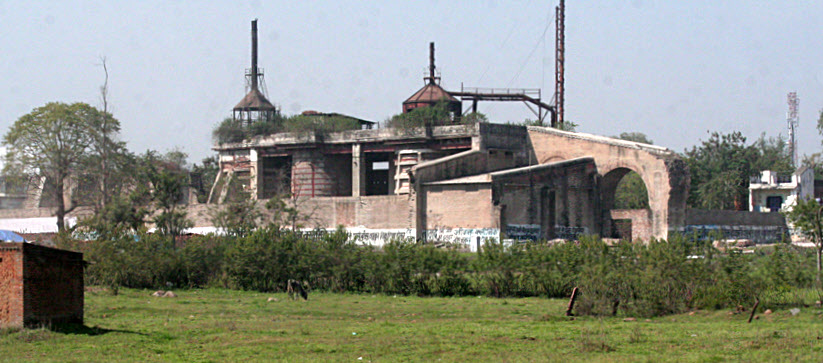
I failed to record properly where "Cement City" is... but Satna, lat/long 24.5804, 80.8412, seems a good candidate. Explore the area with Google.maps.com, using the aerial images.
The left hand image above is of one of the smaller plants, and as you can see from the right hand image, industry is not recently come to the area.
Why here? The balance of raw materials, transport, demand would make an interesting study, I suspect. I think there is coal, in surface beds, here, and if so that would be a major factor.
It would also be part of the answer for why there were extensive brick making operations. I failed to get good photos, but the process seemed to depend extensively on man-power, not machines. In looking for Cement City, I found the following image of a brickyard, at 24.54692, 80.79776, one of many in the area.
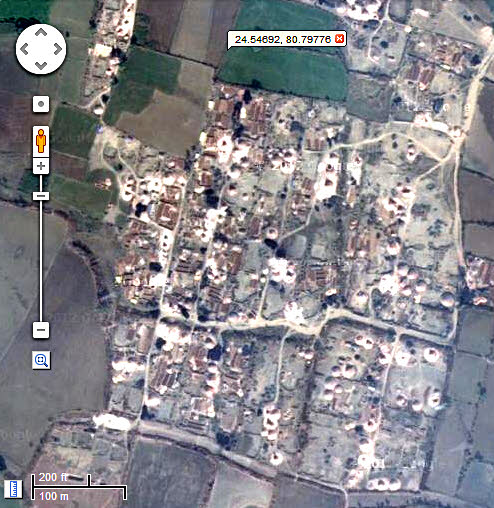
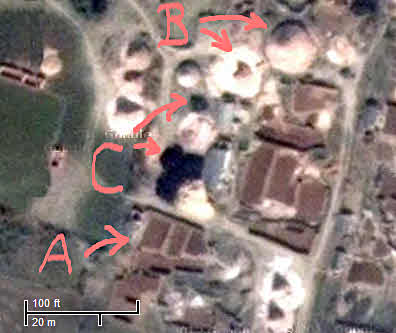
A: Recently shaped bricks, drying in sun. Made mostly by hand, as far as I could see. Perhaps some machinery helping.
B: "Ovens", the lower one being built. Craftily stacked un-fired bricks, interspersed with coal, "buried" under an outer "case" of clay. Like a charcoal maker's "oven", but for bricks. Stacked by hand... and subsequently un-stacked by hand.
C: Partly the shadow of one of the ovens, but also, and all of the upper black blob: Coal.
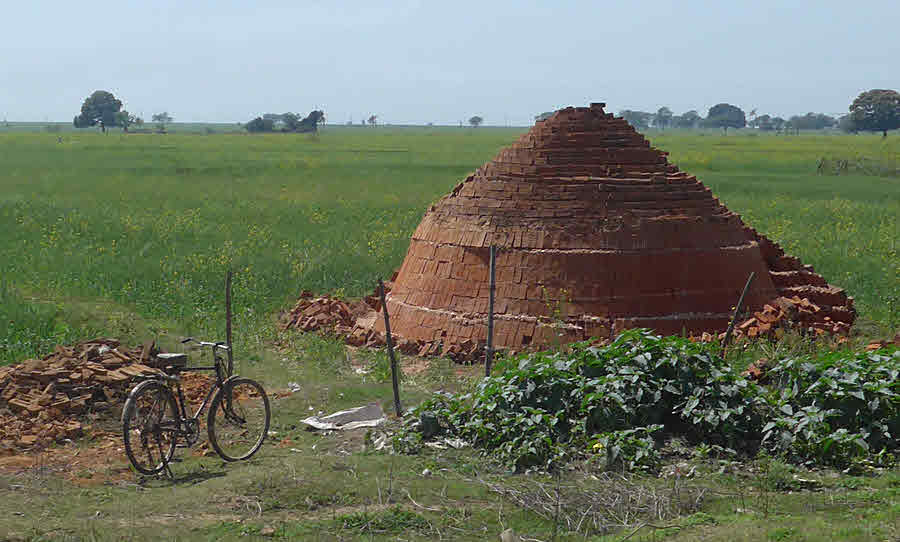
By the time I "woke up" and started trying to photograph a brick production yard, we'd nearly passed through the area. Of course, the huge yards, as seen via Google.maps, weren't visible from the road. But production took place on many scales, this being one of the smallest operations I saw. This is one of the "ovens", ready for firing, or perhaps cooling, after firing.
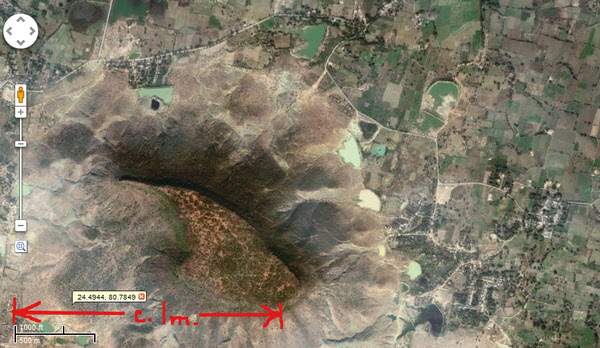
A coal mine, I think, and associated industry. At 24.4944, 80.7849. Red line is about a mile long.
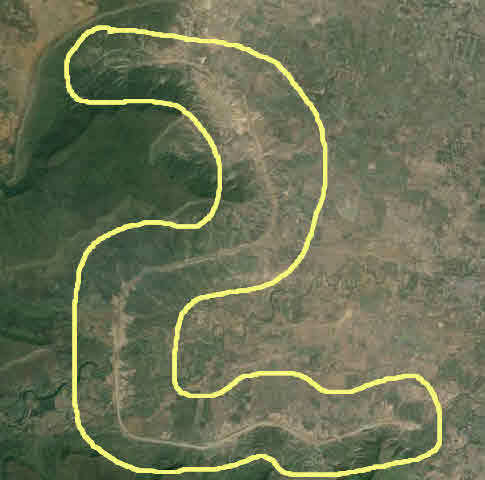
Have a little Google.maps hunt yourself. Use logic. There's some interesting stuff at 24.4623, 80.7358. It seems similar to (if not part of) the amazing "thing" around 24.3892, 80.7409, which you can only begin to see when you've zoomed in almost too far to see it all at once. Once you find it, zoom in further, study it. And note some seemingly undisturbed geology of similar shape in the area. "Ribbons" containing some valuable deposit? The "thing" is only one of at least two of its kind in the area. The "thing" is about three miles "high". It would seem that heavy machinery does get used, sometimes.
There's an almost 2000 foot long train on the tracks south of Satna, just north of Unchhera.
Going back to concrete: All over the areas we traveled, we came across multiple major projects to provide a serious bridge, in concrete, over a river. Another example of spending by Delhi on infrastructure which will improve lives for many years to come, without creating high maintenance expenses.
The cement works were, I thought, to the west of the road north from Unchhera to Satna. That area makes interesting searching. But if you follow the railway line to the north of the road east from Satna, to Rewa, looking out for sidings... that's the sort of "logic" I was hinting at... you find things like...
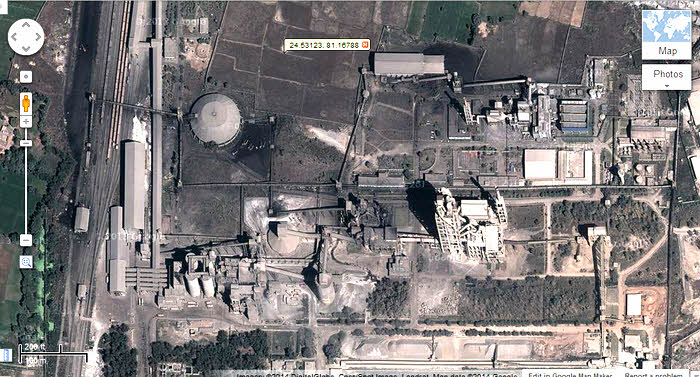
... which is at 24.53123, 81.16788
Next, a little discourse on the rubber re-cycling man.
The day's mini-stop to for the drivers' tea break was at a spot similar to the one described in my account of the drive of the 5th.
In a very modest structure, I met a very friendly man who made his living, at least in part, by recycling truck tires. (Battered tires are not in short supply here!)
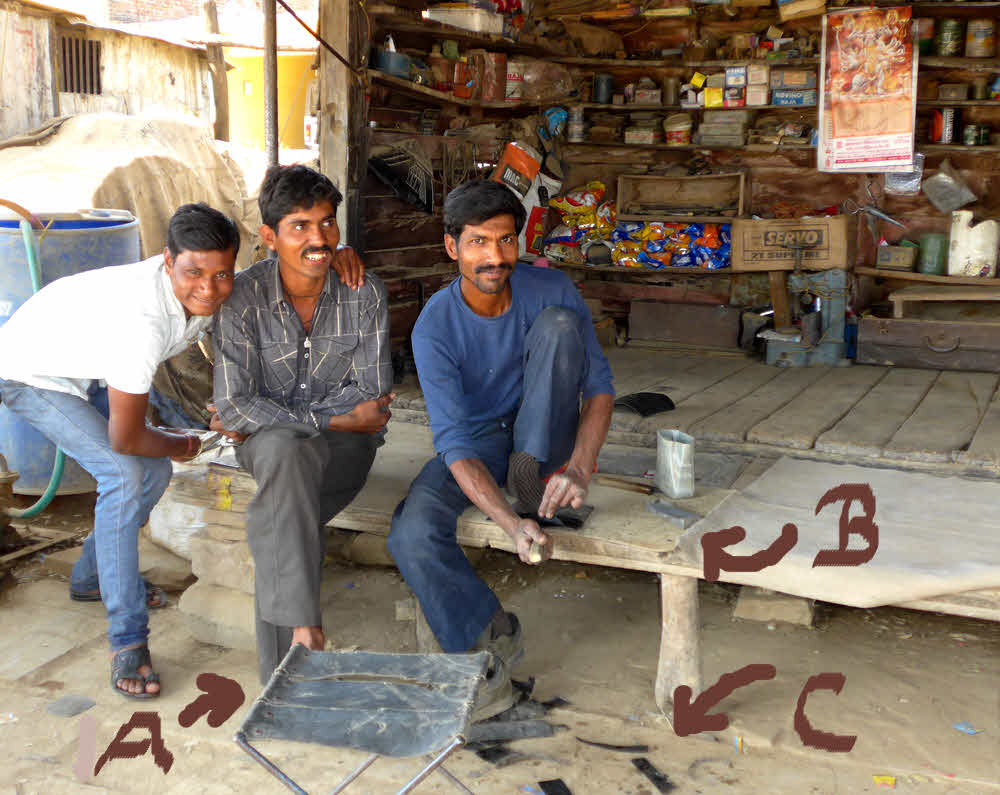
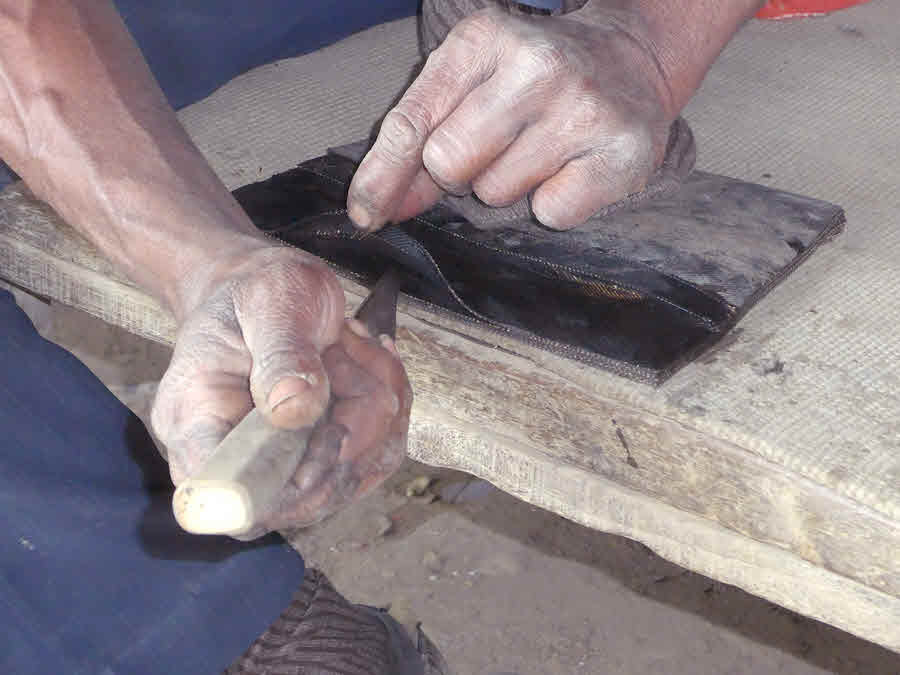
The right hand image gives you the overall picture... and I do mean "overall"... there was very little more to his business premises than you see here. He'd had the business for a dozen years.
Besides whatever his "main" business was, he was re-cycling tires rather ingeniously. In the image on the left, you see him slicing pieces... about 7cm x 12cm... from tires. ("C" in the overview.) Thin pieces. I suspect he would have liked to cut larger pieces, but to cut them thin(?), he did it little at a time.
His tools? A many-times sharpened knife, a whetstone ("B" in the overview, his left foot (to pin down the piece of tire he was working on. (He's in the midst of doing some slicing in the overview picture.) And a little water... he always kept what he was working on wet. It seemed to help the knife slip through the rubber lamellae.
What for? Many things, I suspect, but what he wanted to sell me was what was actually quite a nice folding stool... "A" in the image. Made from a hand crafted iron rod frame, and joined up bits of thinly sliced old tire. The frame, of course, also hand crafted. (I often saw people working effectively in iron.)
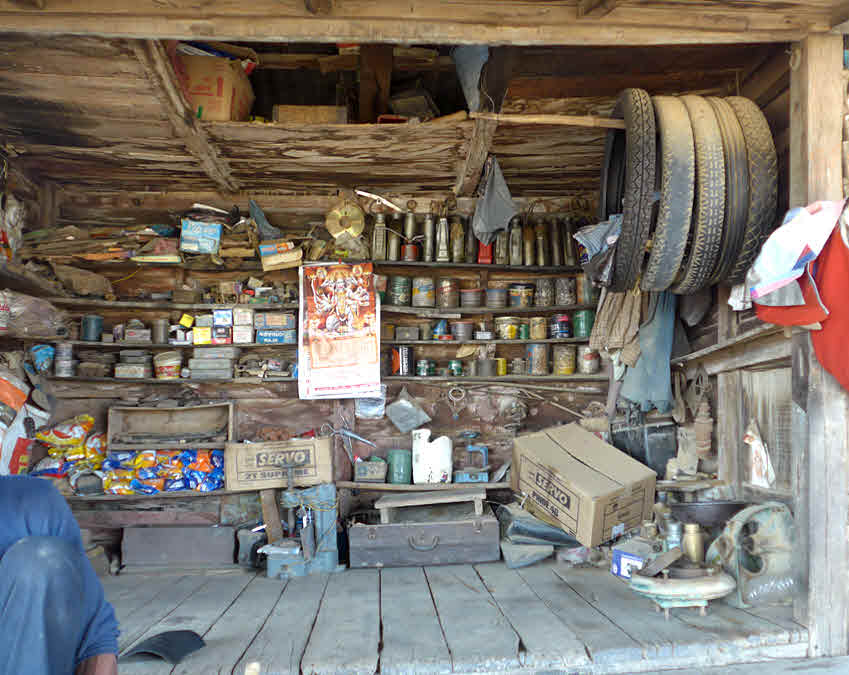
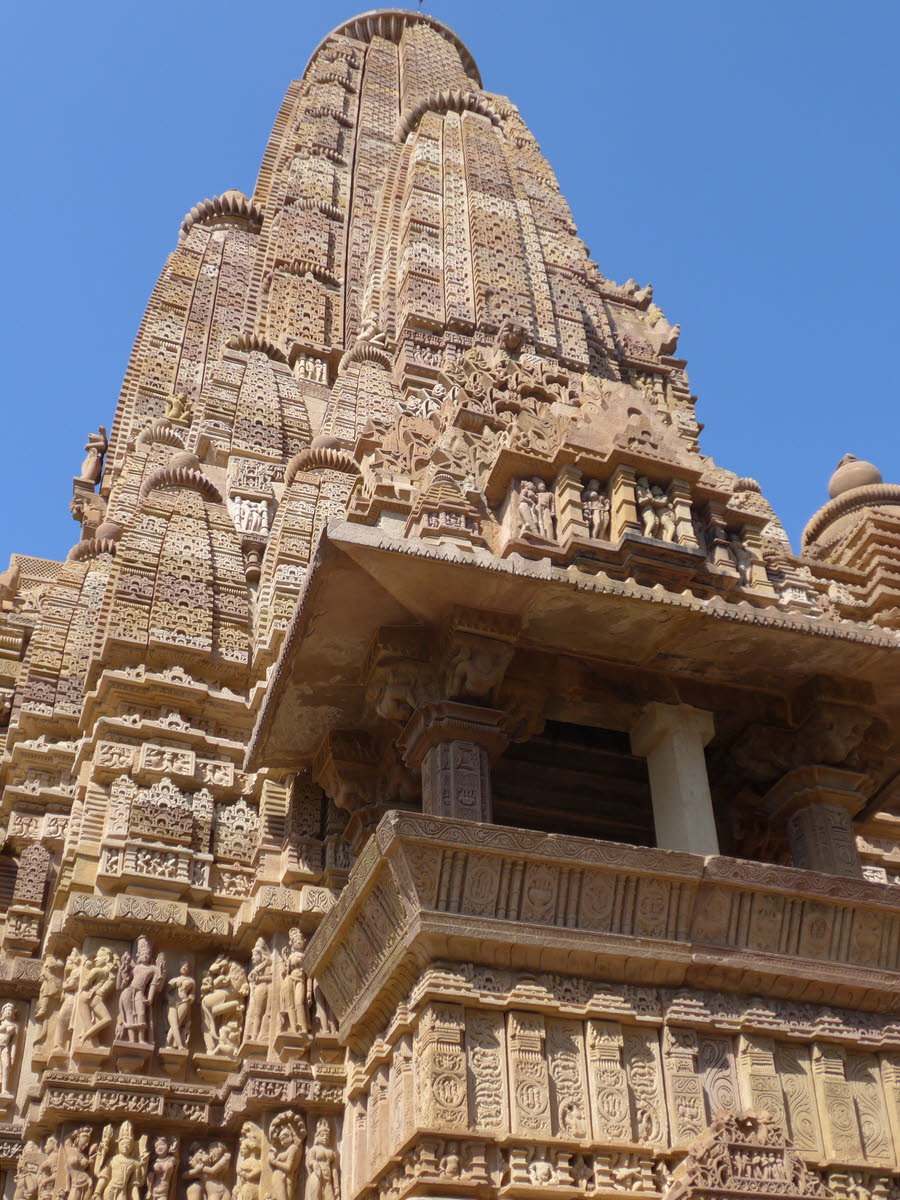
And, just before the "joys" of flying to Delhi, for a fight with the traffic to (briefly) win the pleasures of the Imperial, two treats... the magnificent Khajuraho temple complex (-WP-), and the tourist oasis associated with it, including a very nice al fresco meal on an upstairs balcony in a good... but not "extravagant"... restaurant. A family place. Our day much helped by our flight being delayed... and knowing in advance that it was delayed. "Things" "fit" into better time slots as a result.
The account of this day needs expanding! I've said a bit about the last part of the day, going the final part of our journey to Shimla on the famous heritage train in the "Culture" page.
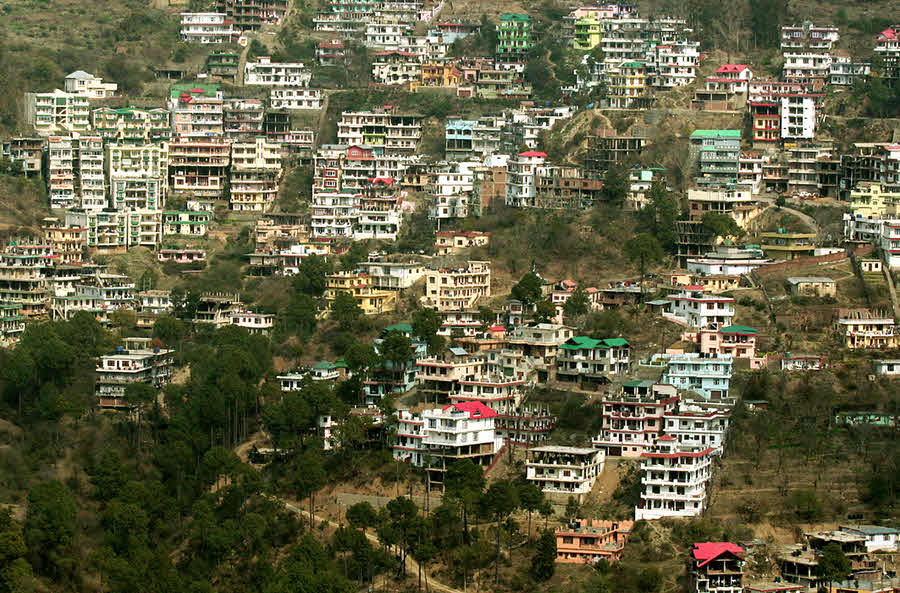
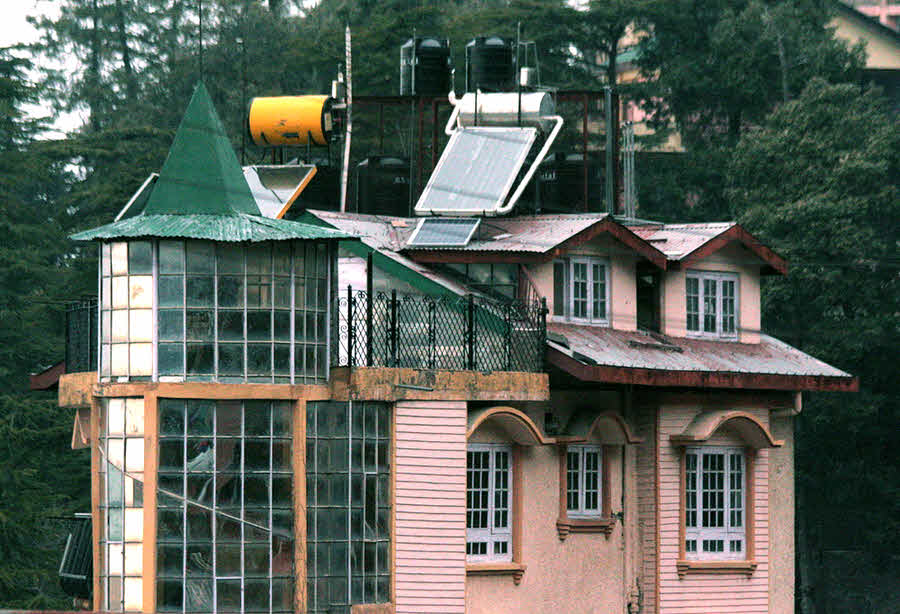
Above left: Development in the hills, not long after leaving Chandrigarh en route to Shimla. What a jigsaw puzzle candidate!
Above right: I hope you've seen the excellent BBC series about India's "hill" railways? This is the home of the station manager at Shimla's Summerhill station. (I hope I have those details right! It was in the series, and is at Summerhill, and the owner was rightly proud of what he had built up over many years of incremental improvement.)
Got up. Checked out of Wildflower Hall. (Reluctantly checked out! Trip coming to an end, and leaving Wildflower Hall would be hard at any time.) Drove... for hours... down from Shimla to Chandrigarh. Took flight to Delhi. Short van ride to airport hotel. Arrived in good time for a nice meal, but not earlier than necessary.
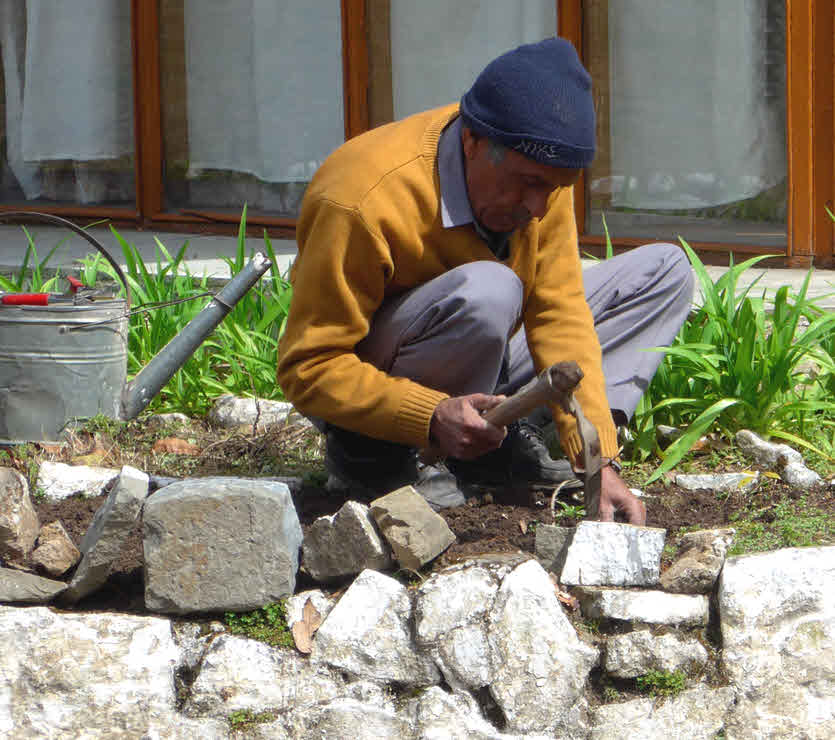
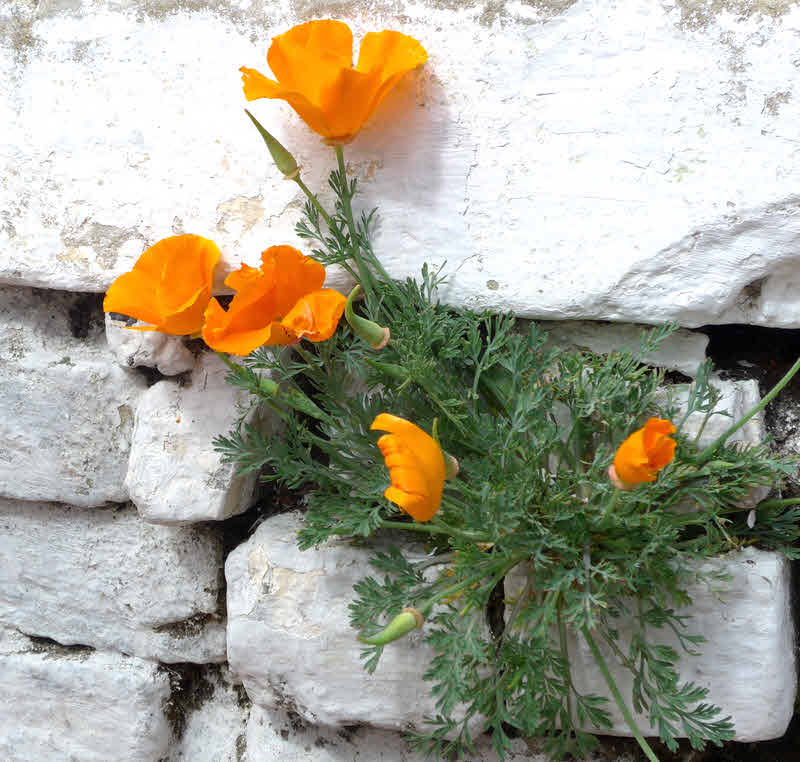
At a roadside cafe we stopped at on the way down from Shimla to Chandigarh. The flower was probably an unplanned "weed"... of the same variety as the one that maintained itself in a crack between by driveway and garage for about 10 years. "California poppy".
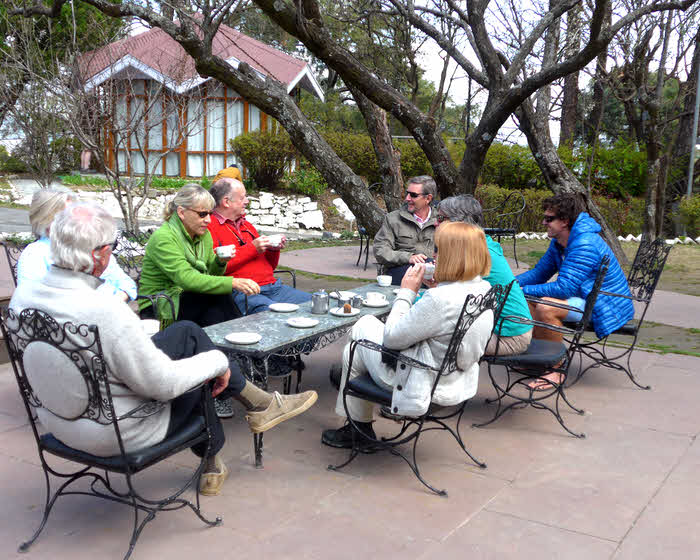
This was an unusually leisurely stop while getting from "A" to "B". I think we'd got out of the hotel ahead of time, the roads weren't as slow as they might have been, and we had "extra" time in hand before our not- too- distant departure by plane from Chandrigarh to Delhi, and this was a nicer place to spend it than the modest airport at Chandrigarh. We were still in the hills, but at this point, only just.
Two final notes on the excellent service by our various drivers. I don't think that we once stopped to buy gas. Even in districts where gas stations were few and far between. Even in the midst of long drives. I just hope that the drivers didn't have far to go to refuel just before or just after an already long day.
And the drivers had every vehicle spotless before each journey, including the glass, which was very helpful to my photography.
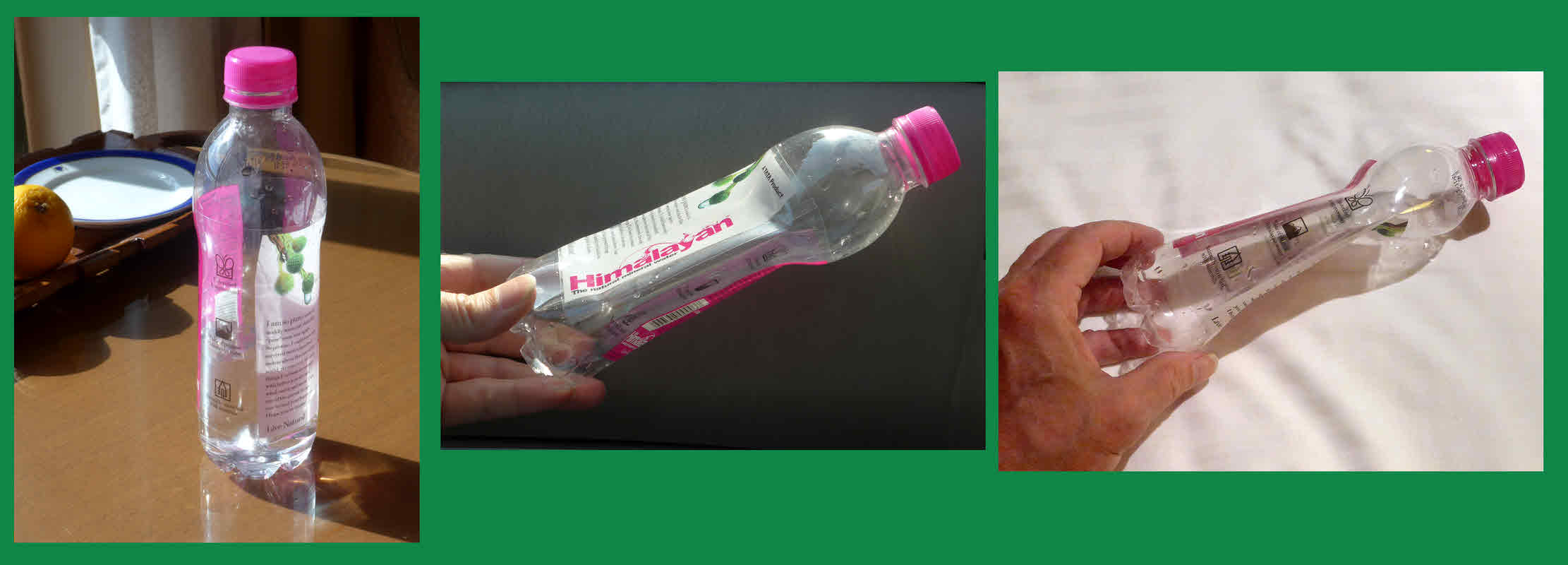
Bottle full of air... not "empty"...
At left: In Shimla (about 8,000 ft above sea level)
Middle: Chandrigarh
Right: Delhi
All of our travel days, seen together in a "lump" may be a little overwhelming? Don't forget what I said at the outset: They really weren't too bad, and certainly were Worth It. Remember that between travel days we had fabulous Adventures, and without the travel days, we would have had to give up some of the experiences we had.
They were, in themselves, interesting experiences, with lots to see and wonder about as we rode along. And the relocations were well executed, with the least enjoyable parts being down to the areas for improvement still open to the Indian domestic airline industry. And to be fair to them, they do operate in a region with some "weather" issues. While the plane we wanted to use might not be taking us close to the highest mountains in the world, it may well have been trying to come from that region, and in that region the weather can be unkind to aviation. But it was annoying that an airline "modern" enough to screw ransom out of passengers who wanted... shock horror!... to bring some luggage "couldn't" manage to take the money from a credit card without a half hour comedy entailing four employees, and a curious additional, cash, of course, charge "to make change". Cash from customer to airline employee. Funny kind of "change", seemed to me. (Actually, it was a fellow traveler who suffered that charge. I think the employees concerned understood that it would be a bad idea to try to levy the charge on my transaction.)
Hmmm... forgive me, for now, ending this page on that note. A small thing, in the bigger picture... but still part of it.
Relevant to all our experiences on the roads...
While it is of course true everywhere that theory does not necessarily coincide with practice, driving on India's roads, for an outsider, is a somewhat arcane mystery.

This "Give Way" (English... which, by the way, very nearly EVERONE we met spoke... for "Yield") sign, for instance, is probably fondly regarded and passionately cared for by several tiers of bureaucrats... but drivers operate to a much simpler rules...
In order of seniority...
Given that you often meet things like...
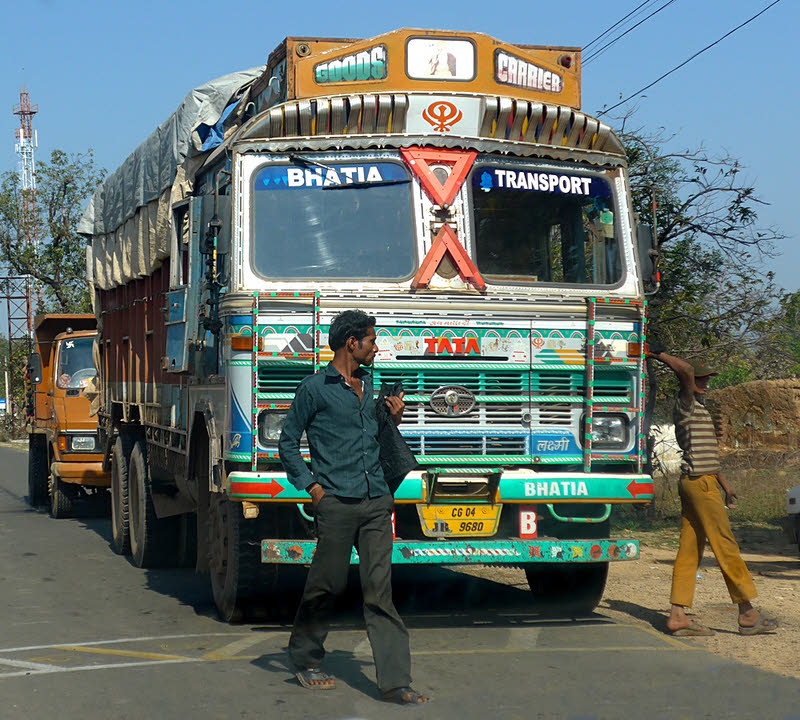
... it is well to understand the local practices.
I will go into the rules (or rather, the fact that there were none that I could discern) and practices of passing (overtaking) later, but as a fore-taste...
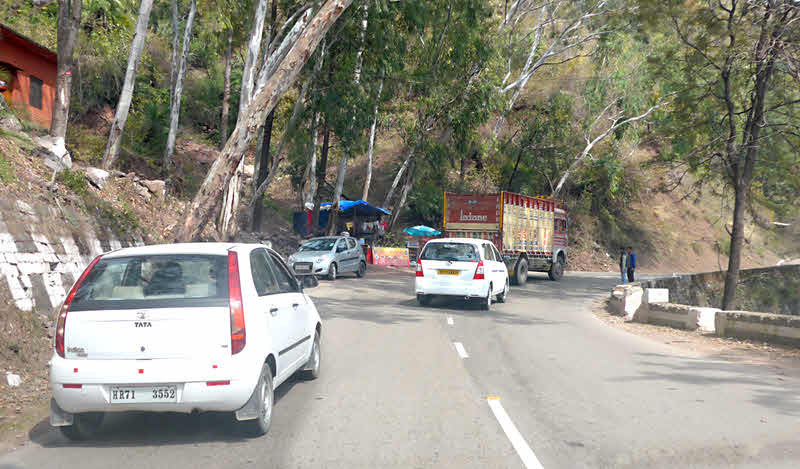
(That's quite a tame example. The pedestrians will probably (... probably...) wait, and give themselves at least 10" clearance from the 35mph car.)
Want to look closely at some image? To zoom in on just bits of it? I explain how, and give some other browsing tips on the linked page.
If you came to this page by clicking on one of the links on the trip's main page, you can just close this tab to return there.
If you find yourself wanting to use a photo on this site, please see my page about using web-published material which is copyright TK Boyd. If you want to contact me, here's my eddress, or you can use the contact form. (Email best, as the contact form is often abused, and I don't read all messages arriving that way.) Corrections to bad information on the pages very welcome... don't be shy!
![]() Page has been tested for compliance with INDUSTRY (not MS-only) standards, using the free, publicly accessible validator at validator.w3.org. Mostly passes. There were two "unknown attributes" in Google Translate and Google+ button code. Sigh.
Page has been tested for compliance with INDUSTRY (not MS-only) standards, using the free, publicly accessible validator at validator.w3.org. Mostly passes. There were two "unknown attributes" in Google Translate and Google+ button code. Sigh.